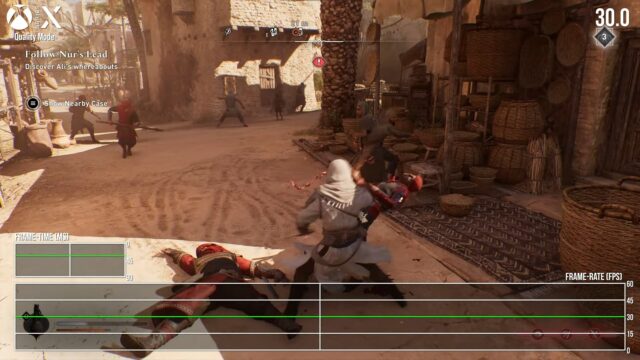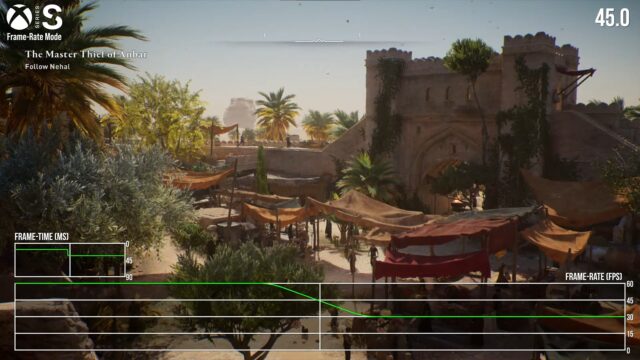Assassin’s Creed Mirage released amidst much hype as it was Ubisoft’s chance to earn back the support of the dedicated fanbase who were tired of the RPG style of gameplay in the three epic Assassin’s Creed titles of Origins, Odyssey, and Valhalla.
Developers Ubisoft Bordeaux grabbed the opportunity with both hands, creating a title that takes players back to the roots of the Assassin’s Creed titles, focusing on stealth and planning instead of mindless button smashing.
Popular gaming outlet Eurogamer tried out Assassin’s Creed Mirage across current-gen and previous-gen consoles. They concluded that all the current-gen consoles provide stable performance in Assassin’s Creed Mirage at both the Fidelity and Performance gaming modes, with negligible frame drops in the Performance mode.
To reach this conclusion, Eurogamer referred to a comprehensive video by Digital Foundry. All consoles, i.e., PS5, Xbox Series, and Series S, have a 60FPS Performance Mode at a slightly lower resolution and Quality Mode running 4K at 30FPS.
When running at 30FPS, the PS5 and Xbox Series X give dynamic 4K, occasionally dipping to 1944p. On the Series S, the dynamic resolution drops to 1620p, which is still decent, sometimes reaching a lowest of 1512p.
Digital Foundry noted no noticeable difference in how PS5 and Xbox Series X render textures and shadows. However, the difference between the Series S and the Series X is pronounced.

The slight margins between the two consoles are worth pointing out. During the big panoramic shots of 9th-century Baghdad, Series S limits the amount of detail that can be displayed regarding trees, houses, and the terrain overall.
In the 60FPS mode, the shadow quality in Series S drops even further. However, it does not look bad per se. The Performance Mode’s resolution drops to 1800p on PS5 and Series X, with the lower bound as 1440p.
In the Series S, the resolution drops to dynamic 1080p with 864p as the lower bound. There is a significant drop in the Level of Detail in geometry and plants.

Digital Foundry suggested players stick to the 30FPS mode, which has few hiccups on all current-gen consoles. The 60 FPS is similarly well-polished. However, any rapid change in POV, like from “sky back down into the city, incurs a sharp rise in GPU load.”
The moment there’s a spike in the GPU load, we witness frame tearing. Because AC: Mirage is so well optimized, players will only notice a single frame or two being dropped at worst. The tearing is more frequent on the Series X.

As for the Series S, the dynamic 1080p pulls through at a relatively steady frame rate of 60FPS. However, unlike the PS5 and Xbox Series X, there is a forced half-refreshed along with in-engine cut-scenes being capped at 30FPS. The Ubisoft Anvil Engine holds up well on scaling to Xbox Series S.
The way Ubisoft Bordeaux managed to create such an intricate and beautiful game but also made it work across all current-gen consoles with little to no hiccups is genuinely admirable. Players can explore Baghdad as Basim in Assassin’s Creed: Mirage.
About Assassin’s Creed Mirage
Assassin’s Creed Mirage is an action-adventure game developed by Ubisoft Bordeaux and published by Ubisoft. The game is the thirteenth primary installment in the Assassin’s Creed series and the successor to 2020’s Assassin’s Creed Valhalla. While its historical timeframe precedes that of Valhalla, its modern-day framing story succeeds Valhalla’s own.
Set in 9th-century Baghdad during the Islamic Golden Age—in particular during the Anarchy at Samarra—the story follows Basim Ibn Ishaq (a character first introduced in Valhalla), a street thief who joins the Hidden Ones to fight for peace and liberty against the Order of the Ancients,[b] who desire peace through control. The main narrative focuses on Basim’s internal struggle between his duties as a Hidden One and his desire to uncover his mysterious past.









No Comments on Assassin’s Creed Mirage frame rates hold up well across all consoles